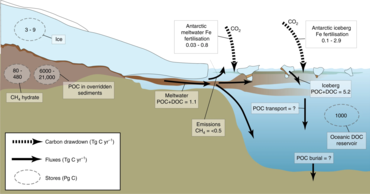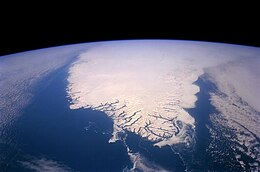
In glaciology, an ice sheet, also known as a continental glacier, is a mass of glacial ice that covers surrounding terrain and is greater than 50,000 km2 (19,000 sq mi). The only current ice sheets are the Antarctic ice sheet and the Greenland ice sheet. Ice sheets are bigger than ice shelves or alpine glaciers. Masses of ice covering less than 50,000 km2 are termed an ice cap. An ice cap will typically feed a series of glaciers around its periphery.
Although the surface is cold, the base of an ice sheet is generally warmer due to geothermal heat. In places, melting occurs and the melt-water lubricates the ice sheet so that it flows more rapidly. This process produces fast-flowing channels in the ice sheet — these are ice streams.
In previous geologic time spans (glacial periods) there were other ice sheets: during the Last Glacial Period at Last Glacial Maximum, the Laurentide Ice Sheet covered much of North America, the Weichselian ice sheet covered Northern Europe and the Patagonian Ice Sheet covered southern South America.
Definition
An ice sheet is "an ice body originating on land that covers an area of continental size, generally defined as covering >50,000 km2 , and that has formed over thousands of years through accumulation and compaction of snow".
Common properties

Estimated carbon fluxes are measured in Tg C a−1 (megatonnes of carbon per year) and estimated sizes of carbon stores are measured in Pg C (thousands of megatonnes of carbon). DOC = dissolved organic carbon, POC = particulate organic carbon.
Ice sheets have the following properties: "An ice sheet flows outward from a high central ice plateau with a small average surface slope. The margins usually slope more steeply, and most ice is discharged through fast-flowing ice streams or outlet glaciers, often into the sea or into ice shelves floating on the sea."
Ice movement is dominated by the motion of glaciers, whose activity is determined by a number of processes. Their motion is the result of cyclic surges interspersed with longer periods of inactivity, on both hourly and centennial time scales.
Until recently, ice sheets were viewed as inert components of the carbon cycle and were largely disregarded in global models. Research in the past decade has transformed this view, demonstrating the existence of uniquely adapted microbial communities, high rates of biogeochemical/physical weathering in ice sheets and storage and cycling of organic carbon in excess of 100 billion tonnes, as well as nutrients (see diagram).
Earth's current two ice sheets
Antarctic ice sheet

The East Antarctic Ice Sheet (EAIS) is one of two large ice sheets in Antarctica, and the largest on the entire planet. The EAIS lies between 45° west and 168° east longitudinally.
The EAIS holds enough ice to raise global sea levels by 53.3 m (175 ft) and is considerably larger in area and mass than the West Antarctic Ice Sheet (WAIS). It is separated from the WAIS by the Transantarctic Mountains. The EAIS is the driest, windiest, and coldest place on Earth, with temperatures reported down to nearly −100 °C. The EAIS holds the thickest ice on Earth, at 4,800 m (15,700 ft). It is home to the geographic South Pole and the Amundsen–Scott South Pole Station.Greenland ice sheet

The Greenland ice sheet (Danish: Grønlands indlandsis, Greenlandic: Sermersuaq) is an ice sheet about 1.67 km (1.0 mi) thick on average, and almost 3.5 km (2.2 mi) at its thickest point. It is almost 2,900 kilometres (1,800 mi) long in a north–south direction, with the greatest width of 1,100 kilometres (680 mi) at a latitude of 77°N, near its northern margin. It covers 1,710,000 square kilometres (660,000 sq mi), around 80% of the surface of Greenland, and is the second largest body of ice in the world, after the East Antarctic ice sheet. It is sometimes referred to as an ice cap, or inland ice or its Danish equivalent, indlandsis. The acronyms GIS or GrIS are also frequently used in the scientific literature.
While Greenland has had major glaciers and ice caps for at least 18 million years, the ice sheet first emerged as a single entity covering most of the island some 2.6 million years ago – a process which required significant changes to Greenland's orography millions of years earlier, as well as the low temperatures due to a reduction in atmospheric carbon dioxide levels. Since then it has both grown, sometimes to a significantly larger size than now, and shrunk, to less than 10% of its volume on at least one occasion around 400,000 years ago, when the temperatures were somewhat warmer than today. Its oldest known ice is about 1 million years old.Melting due to climate change
The melting of the Greenland and West Antarctic ice sheets will continue to contribute to sea level rise over long time-scales. The Greenland ice sheet loss is mainly driven by melt from the top. Antarctic ice loss is driven by warm ocean water melting the outlet glaciers.
Future melt of the West Antarctic ice sheet is potentially abrupt under a high emission scenario, as a consequence of a partial collapse. Part of the ice sheet is grounded on bedrock below sea level. This makes it possibly vulnerable to the self-enhancing process of marine ice sheet instability. Marine ice cliff instability could also contribute to a partial collapse. But there is limited evidence for its importance. A partial collapse of the ice sheet would lead to rapid sea level rise and a local decrease in ocean salinity. It would be irreversible for decades and possibly even millennia. The complete loss of the West Antarctic ice sheet would cause over 5 metres (16 ft) of sea level rise.
In contrast to the West Antarctic ice sheet, melt of the Greenland ice sheet is projected to take place more gradually over millennia. Sustained warming between 1 °C (1.8 °F) (low confidence) and 4 °C (7.2 °F) (medium confidence) would lead to a complete loss of the ice sheet. This would contribute 7 m (23 ft) to sea levels globally. The ice loss could become irreversible due to a further self-enhancing feedback. This is called the elevation-surface mass balance feedback. When ice melts on top of the ice sheet, the elevation drops. Air temperature is higher at lower altitudes, so this promotes further melting.In geologic timescales
Antarctic ice sheet during geologic timescales

The icing of Antarctica began in the Late Palaeocene or middle Eocene between 60 and 45.5 million years ago and escalated during the Eocene–Oligocene extinction event about 34 million years ago. CO2 levels were then about 760 ppm and had been decreasing from earlier levels in the thousands of ppm. Carbon dioxide decrease, with a tipping point of 600 ppm, was the primary agent forcing Antarctic glaciation. The glaciation was favored by an interval when the Earth's orbit favored cool summers but oxygen isotope ratio cycle marker changes were too large to be explained by Antarctic ice-sheet growth alone indicating an ice age of some size. The opening of the Drake Passage may have played a role as well though models of the changes suggest declining CO2 levels to have been more important.
The Western Antarctic ice sheet declined somewhat during the warm early Pliocene epoch, approximately 5 to 3 million years ago; during this time the Ross Sea opened up. But there was no significant decline in the land-based Eastern Antarctic ice sheet.Greenland ice sheet during geologic timescales

While there is evidence of large glaciers in Greenland for most of the past 18 million years, they were more similar to various smaller modern formations, such as Maniitsoq and Flade Isblink, which cover 76,000 and 100,000 square kilometres (29,000 and 39,000 sq mi) around the periphery. The conditions in Greenland were not initially suitable to enable the presence of a single cohesive ice sheet, but this began to change around 10 million years ago, during the middle Miocene, when the two passive continental margins which now form the uplands of West and East Greenland had experienced uplift for the first time, which ultimately formed the Upper Planation Surface at a 2000 to 3000 meter height above mean sea level.
Later, during the Pliocene, a Lower Planation Surface, with the 500 to 1000 meter height above sea level, was formed during the second stage of uplift 5 million years ago, and the third stage had created multiple valleys and fjords below the planation surfaces. These increases in height had intensified glaciation due to increased orographic precipitation and cooler surface temperatures, which made it easier for ice to accumulate during colder periods and persist through higher temperature fluctuations. While as recently as 3 million years ago, during the Pliocene warm period, Greenland's ice was limited to the highest peaks in the east and the south, ice cover had gradually expanded since then, until the atmospheric CO2 levels dropped to between 280 and 320 ppm 2.7–2.6 million years ago, which had reduced the temperatures sufficiently for the disparate ice caps build up in the meantime to connect and cover most of the island.

Often, the base of ice sheet is warm enough due to geothermal activity to have some liquid water beneath it. This liquid water, subject to great pressure from the continued movement of massive layers of ice above it, becomes a tool of intense water erosion, which eventually leaves nothing but bedrock below the ice sheet. However, there are parts of the Greenland ice sheet, near the summit, where the upper layers of the ice sheet slide above the lowest layer of ice which had frozen solid to the ground, preserving ancient soil, which can then be discovered when scientists drill ice cores, up to 4 kilometres (2.5 mi) deep. The oldest such soil had been continuously covered by ice for around 2.7 million years, while another, 3 kilometres (1.9 mi) deep ice core from the summit reveals ice that is around ~1,000,000 years old.
On the other hand, ocean sediment samples from the Labrador Sea provide evidence that nearly all of south Greenland had melted around 400,000 years ago, during the Marine Isotope Stage 11, and other ice core samples, taken from Camp Century in northwestern Greenland at a depth of 1.4 km (0.87 mi), demonstrate that the ice there melted at least once during the past 1.4 million years, during the Pleistocene, and that it did not return for at least 280,000 years. Taken together, these findings suggest less than 10% of the current ice sheet's volume was left during those geologically recent periods, when the temperatures were less than 2.5 °C (4.5 °F) warmer than preindustrial, which contradicts how climate models typically simulate continuous presence of solid ice under those conditions.